| Revision as of 23:54, 30 June 2007 view source24.24.138.119 (talk)No edit summary← Previous edit | Latest revision as of 21:23, 20 October 2024 view source Pburka (talk | contribs)Autopatrolled, Extended confirmed users, Pending changes reviewers30,842 edits →Types: Grammar (or, not and)Tags: Mobile edit Mobile web edit Advanced mobile edit | ||
| Line 1: | Line 1: | ||
| {{Short description|Furniture for seating two or more people}} | |||
| {{Otheruses}} | |||
| {{pp-semi-indef|small=yes}} | |||
| {{unreferenced||date=June 2006}} | |||
| {{Other uses}} | |||
| {{redirect-multi|2|Sofa|Settee}} | |||
| {{Redirect|3 Piece Suite|the band|3 Piece Suite (band)|the outfit|three-piece suit}} | |||
| ] | |||
| A '''couch''', also known as a '''sofa''', '''settee''', '''chesterfield''', or ''']''', is a ]ed item of ] that can seat multiple people. It is commonly found in the form of a ] with ] ]s and is often fitted with ] and tailored ] and ].<ref>{{cite web |url= http://dictionary.reference.com/browse/couch |title= Couch |publisher=Dictionary.com (American Heritage Dictionary) |access-date=2012-08-15}}</ref><ref name="thefreedictionary">{{cite web| url= http://www.thefreedictionary.com/couch| title= Couch| publisher=The Free Dictionary By Farlex| access-date=2012-05-12}}</ref> Although a couch is used primarily for ], it may be used for ].<ref>{{cite web| url= http://www.merriam-webster.com/dictionary/couch| title= Couch| publisher=Merriam-Webster| access-date=2012-05-12}}</ref> In homes, couches are normally put in the family room, ], den, or lounge. They are sometimes also found in non-residential settings such as ]s, ] of commercial offices, ]s, and ]. Couches can also vary in size, color, and design. | |||
| ] | |||
| ] | |||
| A '''couch''', and a '''sofa''', '''settee''', '''lounge''', ''']''' or '''chesterfield''' are items of ] for the comfortable seating of more than one person. Compare the joiner's ], with its separate seat cushions. | |||
| ==Etymology== | |||
| Couches are usually to be found in the ], den or the ]. They come in a variety of ]s and in ]. A typical couch seats two to three people and has an armrest on either side. Many different types of couches exist; popular types include the ]. the ], the canapé or the ]. Also, to conserve space, some sofas double as ]s (sofa-bed, daybed, or ]). | |||
| The term ''couch'' originally denoted an item of furniture for lying or sleeping on.<ref>{{cite book |title=People and furniture: a social background to the English home. |last=Harrison |first=Molly |year=1971 |publisher=Ernest Benn |isbn=978-0-8747-10373 |page= |url-access=registration |url=https://archive.org/details/peoplefurnitures00harr/page/55 }}</ref><ref>{{Cite book |chapter-url=https://books.google.com/books?id=gDR9pIE8IhIC&pg=PA135 |chapter=Home, Hearth, and Family |title=Now You Know Big Book of Answers |last=Lennox |first=Doug |year=2007 |publisher=Dundurn |isbn=978-1-55002-741-9 |language=en |via=Google Books |access-date=June 20, 2018}}</ref> ''Couch'' is predominantly used in ], ], ], and ], whereas the terms ''sofa'' and ''settee'' (]) are most commonly used in the ] and ].<ref>{{Cite web |url=https://www.oxfordlearnersdictionaries.com/definition/collocations/couch|title=couch noun |url-access=subscription |website=Oxford Collocations Dictionary |access-date=June 19, 2020}}</ref> The word ''couch'' originated in ] from the ] noun ''{{lang|fro|couche}}'', which derived from the verb meaning "to lie down".<ref>], ''couch'': Middle English from Old French ''culche'', ''couche'' > ''couchier'', ''coucher''.</ref> | |||
| The word ''sofa'' comes from the ]<ref>{{Citation |title=sofa |date=2022-07-03 |url=https://en.wiktionary.org/search/?title=sofa&oldid=67602937 |work=Wiktionary |language=en |access-date=2022-07-06}}</ref><ref>{{Cite web |title=sofa {{!}} Etymology, origin and meaning of sofa by etymonline |url=https://www.etymonline.com/word/sofa |access-date=2022-07-06 |website=www.etymonline.com |language=en}}</ref><ref>{{Cite web |title=Definition of SOFA |url=https://www.merriam-webster.com/dictionary/sofa |access-date=2022-07-06 |website=www.merriam-webster.com |language=en}}</ref><ref>{{Cite web |title=Sofa, Couch or Settee: The History Of Where Each Word Came From |date=18 October 2018 |url=https://www.nabru.co.uk/blog/sofa-couch-or-settee-the-history-of-where-each-word-comes-from/}}</ref> language and is derived from the ] word ''{{transliteration|ar|suffah}}'' ("ledge/bench"), cognates with the ] word ''{{lang|arc|sippa}}'' ("]").<ref>], ''sofa'': Turkish, from Arabic ''suffah'', from Aramaic ''sippa'', ''sippəta''.</ref> ] in his ''Dictionarium Britannicum'' (1730) defines sofa as a "a sort of alcove much used in Asia ... furnished with rich carpets and cushions."{{sfn|Gloag|Edwards|1991|p=597|loc=Settee}} | |||
| ⚫ | |||
| The word ''settee'' or ''setee'' comes from the ] word ''{{lang|ang|setl}}'', which was used to describe long benches with high backs and arms, but is now generally used to describe small upholstered seating structures.<ref>{{Cite web|title=Definition of settee {{!}} Dictionary.com|url=https://www.dictionary.com/browse/settee|access-date=2020-10-02|publisher=www.dictionary.com|language=en}}</ref> Both "sofa" and "settee" terms came into use in the beginning of the 18th century. Originally the settee defined a smaller sofa, but by the 20th century the distinction was lost.{{sfn|Gloag|Edwards|1991|p=597|loc=Settee}} | |||
| A three-piece suite is composed of three couch pieces (generally, a two- or three-seater and two armchairs). | |||
| Other terms which can be synonymous with the above definition are ]'', '']'', ''lounge'', and '']''.<ref name="thefreedictionary" /> | |||
| ⚫ | == |
||
| In ], the word ''chesterfield'' is used to describe any couch or sofa,<ref>{{cite book |editor1-last=Barber |editor1-first=Katherine |title=Canadian Oxford Dictionary |year=2004 |publisher=Oxford University Press |isbn=978-0-19-541816-3 |page=264 |edition=Second |access-date= |quote=any couch or sofa}}</ref> particularly among older Canadians. According to a 1992 survey conducted in the ] region of ], the term is quickly vanishing.<ref>Chambers, J. K. "The Canada-U.S. border as a vanishing isogloss: the evidence of chesterfield". ''Journal of English Linguistics''; 23 (1995): 156–66, excerpt at {{Webarchive|url=https://web.archive.org/web/20070912210235/http://www.chass.utoronto.ca/~chambers/couch.html |date=2007-09-12 }}.</ref> | |||
| ], by ], 1800: a ] couch] with ] design.]] | |||
| Until the ] a ''couch'' referred to a long upholstered seat with one end inclined, high enough to provide a back and head-rest. "Couch" which in the Late Middle Ages had signified bedding (from the French ''se coucher'', or "to go to sleep") was interchangeable with "]" through the ]. (Gloag, "couch"). Well into the ] a couch was particularly a seat for a lady; a ''fainting couch'' (a modern term) has a back and a single scrolling upholstered end. A ''récamier'' was a late nineteenth-century trade term for a similar single-ended couch, such as the one made famous in ]'s portrait of Mme Récamier (''illustration, right''). | |||
| The ''sopha'' or ''sofa'' had a separate origin. "Sopha" made its entry in written English in 1717 ('']''); '']'' preceded it (1702). ''Sofa'' was originally an ] word for the raised section of floor, furnished with rugs and cushions, set apart for a council (see ]) thus also for especially esteemed guests. Designs for "sophas" in ]'s ''Director'' (1754, 1762) all have solidly upholstered arms with padded elbow rests, cushioned seats and upholstered backs, but show their carved wood framing. | |||
| ⚫ | == Types == | ||
| Further back in ancient Roman society, the couch was found in the dining room (known as the '']''). Three couches would be arranged around a low table and the men would recline while eating (although the women sat in normal chairs). | |||
| ] sofa at the ] museum, 2012]] | |||
| ] | |||
| ⚫ | The most common types of couches include the two-seater, sometimes referred to as a loveseat, and the sofa. The loveseat is designed for seating two people, while the sofa has more than two cushion seats. A sectional sofa, often just referred to as a "sectional", is formed from multiple sections (typically two, three, or four) and usually includes at least two pieces which join at an angle of 90 degrees or slightly greater. Sectional sofas are used to wrap around walls or other furniture. | ||
| Other variants include the ], the ] (backless or partial-backed) and the canapé (an ornamental three-seater). To conserve space, some sofas double as ] in the form of ]s, ]s, or ]s. | |||
| Originally it was an ] piece of furniture and it was not until ] that the upholstered couch became an indispensable item of furniture in ] and ] ]s. Throughout its history it has often been an object of derision, considered a variety of things from ] to ]. | |||
| ] (1910)]] | |||
| Since 19th Century the couch has become associated with ]ian ]. Freud originally used the couch as a tool to aid his ] of the patient. However when he moved on from hypnosis to ] discourse as his dominant mode of analysis with the development of the ], he still held on to the couch. He justified this with the need to limit the ] between psychoanalyst and analysand. Thus, the couch proved particularly useful because it limits the visibility of the analyst. | |||
| A furniture set consisting of a sofa with two matching ]s<ref>{{cite web |url= http://dictionary.cambridge.org/dictionary/british/three-piece-suite?q=three-piece+suite |title=Three-piece-suite |publisher=Cambridge Dictionaries Online |access-date=2012-05-12}}</ref> is known as a "chesterfield suite"<ref>{{cite web |url= http://www.thefreedictionary.com/couch |title= Chesterfield suite |publisher=Merriam-Webster |access-date=2012-05-12}}</ref> or "living-room suite".<ref>{{cite web |url=http://dictionary.cambridge.org/dictionary/british/living-room-suite?q=living+room+suite |title=Living room suite |publisher=Cambridge Dictionaries Online |access-date=2012-05-12}}</ref> In the UK, the word ''chesterfield'' was used to refer to any couch in the 1900s. A chesterfield now describes a deep buttoned sofa, usually made from leather, with arms and back of the same height. The first chesterfield, with its distinctive deep buttoned, quilted (or "tufted"<ref>{{Cite web |last=Wade |first=Olin |date=2022-07-24 |title=What is the purpose of tufting? |url=https://www.remodelormove.com/what-is-the-purpose-of-tufting/ |access-date=2024-08-04 |website=www.remodelormove.com |language=en-us}}</ref>) leather upholstery and lower seat base, was commissioned by ] (1694–1773). | |||
| ] jumping on a couch]] | |||
| == Materials == | |||
| Today the couch is invariably linked to both domestic ] life and ] culture. It is often positioned in relation to the ] in a living room and for napping. It has spawned social phenomena such as the ], a person who spends a lot of time watching the television. The couch has also become the central ] for many TV ]s and ]s. This ], through which the couch has shifted from the private to the public sphere, has been satirically depicted in popular culture, in television series such as '']'', ''],'' ], ], and '']''. ] received a good deal of ridicule in ] for jumping the couch on ] as a way of professing his love for ]. The couch was also featured prominently in the famous "Rick James/Charlie Murphy" sketch on Chappelle show. | |||
| A couch consists of a frame, springs, padding, and a covering. The frame is usually made of wood, but can also be made of steel, plastic or laminated boards. Sofa padding is made from foam, down, feathers, fabric or a combination thereof. Sofa coverings are usually made out of soft leather, corduroy or linen. Couches commonly have springs under the padding for more support, although some don't.<ref name="sofa">{{cite web |last1=Kramer |first1=Jennifer |title=How products are made |url=https://www.encyclopedia.com/literature-and-arts/fashion-design-and-crafts/interior-design-and-home-furnishings/sofa |website=encyclopedia.com |access-date=22 June 2022}}</ref> | |||
| == Image gallery == | |||
| <gallery mode="packed"> | |||
| File:N°0407 canapé 'Vallois' réalisé par les Ateliers Allot Frères.jpg|A two-seater ] loveseat | |||
| File:Sofa3800ppx.jpg|A leather couch | |||
| File:ملایر .مبل.jpg|Sofa steel production ] | |||
| File:Couch Furniture.JPG|An upholstered couch | |||
| File:Settee Attributed to Joseph Walter, c. 1770.jpg|English Settee, c. 1770 | |||
| File:Couch MET figure 178R7 24B.jpg|Roman style couch for reclining | |||
| </gallery> | |||
| == See also == | == See also == | ||
| * ] | |||
| {{commonscat|Couches}} | |||
| * ], a similar elongated piece intended for a single person | |||
| *] | |||
| *] | * ] | ||
| *] | * ] | ||
| *] | * ] | ||
| *] | * ] | ||
| *] | * ] | ||
| * ], wooden furniture with similar usage | |||
| * ] | |||
| * ] | |||
| * ] | |||
| == |
== Citations == | ||
| {{Reflist|30em}} | |||
| *John Gloag, ''A Short Dictionary of Furniture'' rev. ed. 1962. (London: Allen & Unwin) | |||
| == General and cited references == | |||
| * {{cite book | last=Gloag | first=John | last2=Edwards | first2=Clive | title=A Complete Dictionary of Furniture | publisher=Overlook Books | publication-place=Woodstock, N.Y | date=1991 | isbn=0-87951-414-0}} | |||
| == Further reading == | |||
| * {{cite encyclopaedia |first=Gordon |last=Campbell |year=2006 |article=Sofa |encyclopedia=The Grove Encyclopedia of Decorative Arts |volume=2 |publisher=Oxford University Press |isbn=978-0-19-518948-3 |page=369}} | |||
| == External links == | == External links == | ||
| * {{Wiktionary-inline}} | |||
| * | |||
| {{Authority control}} | |||
| ] | |||
| ] | |||
| ] | ] | ||
| ] | ] | ||
| ] | ] | ||
| ] | |||
| ] | |||
| ] | |||
| ] | |||
| ] | |||
| ] | |||
| ] | |||
| ] | |||
| ] | |||
| ] | |||
| ] | |||
| ] | |||
Latest revision as of 21:23, 20 October 2024
Furniture for seating two or more peopleFor other uses, see Couch (disambiguation). "Sofa" and "Settee" redirect here. For other uses, see Sofa (disambiguation) and Settee (disambiguation). "3 Piece Suite" redirects here. For the band, see 3 Piece Suite (band). For the outfit, see three-piece suit.
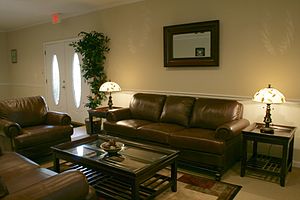
A couch, also known as a sofa, settee, chesterfield, or davenport, is a cushioned item of furniture that can seat multiple people. It is commonly found in the form of a bench with upholstered armrests and is often fitted with springs and tailored cushion and pillows. Although a couch is used primarily for seating, it may be used for sleeping. In homes, couches are normally put in the family room, living room, den, or lounge. They are sometimes also found in non-residential settings such as hotels, lobbies of commercial offices, waiting rooms, and bars. Couches can also vary in size, color, and design.
Etymology
The term couch originally denoted an item of furniture for lying or sleeping on. Couch is predominantly used in North America, Australia, South Africa, and Ireland, whereas the terms sofa and settee (U and non-U) are most commonly used in the United Kingdom and India. The word couch originated in Middle English from the Old French noun couche, which derived from the verb meaning "to lie down".
The word sofa comes from the Turkish language and is derived from the Arabic word suffah ("ledge/bench"), cognates with the Aramaic word sippa ("mat"). Nathan Bailey in his Dictionarium Britannicum (1730) defines sofa as a "a sort of alcove much used in Asia ... furnished with rich carpets and cushions."
The word settee or setee comes from the Old English word setl, which was used to describe long benches with high backs and arms, but is now generally used to describe small upholstered seating structures. Both "sofa" and "settee" terms came into use in the beginning of the 18th century. Originally the settee defined a smaller sofa, but by the 20th century the distinction was lost.
Other terms which can be synonymous with the above definition are divan, davenport, lounge, and canapé. In Canadian English, the word chesterfield is used to describe any couch or sofa, particularly among older Canadians. According to a 1992 survey conducted in the Golden Horseshoe region of Ontario, the term is quickly vanishing.
Types


The most common types of couches include the two-seater, sometimes referred to as a loveseat, and the sofa. The loveseat is designed for seating two people, while the sofa has more than two cushion seats. A sectional sofa, often just referred to as a "sectional", is formed from multiple sections (typically two, three, or four) and usually includes at least two pieces which join at an angle of 90 degrees or slightly greater. Sectional sofas are used to wrap around walls or other furniture.
Other variants include the divan, the fainting couch (backless or partial-backed) and the canapé (an ornamental three-seater). To conserve space, some sofas double as beds in the form of sofa beds, daybeds, or futons.
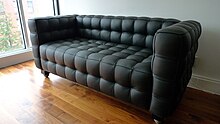
A furniture set consisting of a sofa with two matching chairs is known as a "chesterfield suite" or "living-room suite". In the UK, the word chesterfield was used to refer to any couch in the 1900s. A chesterfield now describes a deep buttoned sofa, usually made from leather, with arms and back of the same height. The first chesterfield, with its distinctive deep buttoned, quilted (or "tufted") leather upholstery and lower seat base, was commissioned by Philip Stanhope, 4th Earl of Chesterfield (1694–1773).
Materials
A couch consists of a frame, springs, padding, and a covering. The frame is usually made of wood, but can also be made of steel, plastic or laminated boards. Sofa padding is made from foam, down, feathers, fabric or a combination thereof. Sofa coverings are usually made out of soft leather, corduroy or linen. Couches commonly have springs under the padding for more support, although some don't.
Image gallery
-
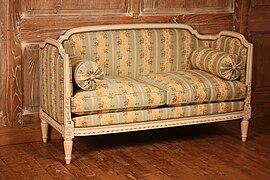 A two-seater upholstered loveseat
A two-seater upholstered loveseat
-
 A leather couch
A leather couch
-
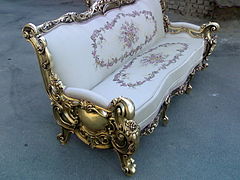 Sofa steel production malayer
Sofa steel production malayer
-
An upholstered couch
-
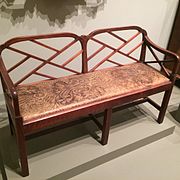 English Settee, c. 1770
English Settee, c. 1770
-
 Roman style couch for reclining
Roman style couch for reclining
See also
- Bean bag chair
- Chaise longue, a similar elongated piece intended for a single person
- Couch potato
- Davenport (sofa)
- Divan (furniture)
- Klippan (sofa)
- Ottoman (furniture)
- Settle (furniture), wooden furniture with similar usage
- Slipcover
- Wing chair
- Window seat (type of sofa)
Citations
- "Couch". Dictionary.com (American Heritage Dictionary). Retrieved 2012-08-15.
- ^ "Couch". The Free Dictionary By Farlex. Retrieved 2012-05-12.
- "Couch". Merriam-Webster. Retrieved 2012-05-12.
- Harrison, Molly (1971). People and furniture: a social background to the English home. Ernest Benn. p. 55. ISBN 978-0-8747-10373.
- Lennox, Doug (2007). "Home, Hearth, and Family". Now You Know Big Book of Answers. Dundurn. ISBN 978-1-55002-741-9. Retrieved June 20, 2018 – via Google Books.
- "couch noun". Oxford Collocations Dictionary. Retrieved June 19, 2020.
- AMHER, couch: Middle English from Old French culche, couche > couchier, coucher.
- "sofa", Wiktionary, 2022-07-03, retrieved 2022-07-06
- "sofa | Etymology, origin and meaning of sofa by etymonline". www.etymonline.com. Retrieved 2022-07-06.
- "Definition of SOFA". www.merriam-webster.com. Retrieved 2022-07-06.
- "Sofa, Couch or Settee: The History Of Where Each Word Came From". 18 October 2018.
- AMHER, sofa: Turkish, from Arabic suffah, from Aramaic sippa, sippəta.
- ^ Gloag & Edwards 1991, p. 597, Settee.
- "Definition of settee | Dictionary.com". www.dictionary.com. Retrieved 2020-10-02.
- Barber, Katherine, ed. (2004). Canadian Oxford Dictionary (Second ed.). Oxford University Press. p. 264. ISBN 978-0-19-541816-3.
any couch or sofa
- Chambers, J. K. "The Canada-U.S. border as a vanishing isogloss: the evidence of chesterfield". Journal of English Linguistics; 23 (1995): 156–66, excerpt at chass.utoronto.ca Archived 2007-09-12 at the Wayback Machine.
- "Three-piece-suite". Cambridge Dictionaries Online. Retrieved 2012-05-12.
- "Chesterfield suite". Merriam-Webster. Retrieved 2012-05-12.
- "Living room suite". Cambridge Dictionaries Online. Retrieved 2012-05-12.
- Wade, Olin (2022-07-24). "What is the purpose of tufting?". www.remodelormove.com. Retrieved 2024-08-04.
- Kramer, Jennifer. "How products are made". encyclopedia.com. Retrieved 22 June 2022.
General and cited references
- Gloag, John; Edwards, Clive (1991). A Complete Dictionary of Furniture. Woodstock, N.Y: Overlook Books. ISBN 0-87951-414-0.
Further reading
- Campbell, Gordon (2006). "Sofa". The Grove Encyclopedia of Decorative Arts. Vol. 2. Oxford University Press. p. 369. ISBN 978-0-19-518948-3.
External links
 The dictionary definition of couch at Wiktionary
The dictionary definition of couch at Wiktionary